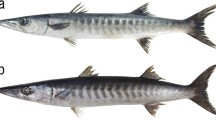Abstract
The lakeweed chub Ischikauia steenackeri is a medium-sized, herbivorous fish and the sole extant member of the genus Ischikauia, which is endemic to Lake Biwa and the Yodo River drainage, Japan. In order to clarify its systematic position, the skeletal anatomy of I. steenackeri is described and its relationships with related genera are discussed. The present data suggest the monophyly of Ischikauia and seven cultrine genera (Culter, Chanodichthys, Megalobrama, Sinibrama, Hemiculter, Toxabramis, and Anabarilius) based on a unique character, the metapterygoid elongated dorsally. Additionally, our data suggest that Ischikauia is closely related to Culter, Chanodichthys, Megalobrama, and Sinibrama. This relationship is supported by three synapomorphies that are common to them: a narrow third infraorbital, dorsal extension of the third supraneural, and a large quadrate foramen.









Similar content being viewed by others
References
Bănărescu P (1967) Studies on the systematics of Cultrinae (Pisces, Cyprinidae) with description of a new genus. Revue Roum Biol Zoologie 12:297–308
Bogutskaya NG, Naseka AM (2004) Catalogue of agnathans and fishes of fresh and brackish waters of Russia with comments on nomenclature and taxonomy. Russian Academy of Sciences, Moscow
Chen WJ, Mayden RL (2009) Molecular systematics of the Cyprinoidea (Teleostei: Cypriniformes), the world’s largest clade of freshwater fishes: further evidence from six nuclear genes. Mol Phylogenet Evol 52:544–549
Conway KW, Britz R (2007) Sexual dimorphism of the Weberian apparatus and pectoral girdle in Sundadanio axelrodi (Ostariophysi: Cyprinidae). J Fish Biol 71:1562–1570
Dai YG, Yang JX, Chen YR (2005) Phylogeny and zoogeography of the subfamily Cultrinae (Cyprinidae). Acta Zootaxonomica Sinica 30:213–233
Fujita K (1989) Nomenclature cartilaginous elements in the caudal skeleton of teleostean fishes. Jpn J Ichthyol 36:22–29
Hayashi T (1975) Fossils from Chojabaru, Iki Island, Japan. Shimano-kagaku-kenkyu-jo, Iki
Hosoya K (1986) Interrelationships of the Gobioninae (Cyprinidae). In: Uyeno T, Arai R, Taniuchi T, Matsuura K (eds) Indo-Pacific fish biology. Japanese Ichthyology Society, Tokyo, pp 484–501
Hosoya K (2002) Cyprinidae. In: Nakabo T (ed) Fishes of Japan with pictorial keys to the species (English edn). Tokai University Press, Tokyo, pp 253–271
Howes GJ (1979) Notes on the anatomy of Macrochirichthys macrochirus (Valenciennes), 1844, with comments on the Cultrinae (Pisces, Cyprinidae). Bull Brit Mus Nat Hist (Zool) 36:147–200
Howes GJ (1991) Systematics and biogeography: an overview. In: Winfield IJ, Nelson JS (eds) Cyprinid fishes, systematics, biology and exploitation. Chapman and Hall, London, pp 1–33
Kawamura K, Hosoya K (1991) A modified double staining technique for making a transparent fish-skeletal specimen. Bull Nat Inst Aquaculture 20:11–18
Kawanabe H (1996) Asian Great Lakes, especially Lake Biwa. Environ Biol Fish 47:219–234
Kottelat M (2001) Freshwater fishes of northern Vietnam. World Bank, Washington, DC
Kusaka T (1974) The urohyal of fishes. University of Tokyo Press, Tokyo
Luo YL, Chen YR (1998) Cultrinae. In: Chen YY (ed) Fauna Sinica (Osteichthyes, Cypriniformes). Science Press, Beijing, pp 112–207
Nakajima T (1986) Pliocene cyprinid pharyngeal teeth from Japan and East Asia Neogene cyprinid zoogeography. In: Uyeno T, Arai R, Taniuchi T, Matsuura K (eds) Indo-Pacific fish biology. Japanese Ichthyology Society, Tokyo, pp 502–513
Nakajima T (1994) Chapter 2 (4d): cyprinid fishes. In: Research Group for Natural History of Lake Biwa (ed) The natural history of Lake Biwa. Yasaka Shobo, Tokyo, pp 235–275
Nichols JT (1943) The fresh-water fishes of China. American Museum of Natural History, New York
Research Group for Natural History of Lake Biwa (1986) Freshwater fossil assemblages from the Pleistocene Kobiwako Group on the southwest side of Lake Biwa. Bull Mizunami Fossil Mus 13:57–103
Rüber L, Kottelat M, Tan HH, Ng PKL, Britz R (2007) Evolution of miniaturization and the phylogenetic position of Paedocypris, comprising the world’s smallest vertebrate. BMC Evol Biol 7:38
Saitoh K, Sado T, Mayden RL, Hanzawa N, Nakamura K, Nishida M, Miya M (2006) Mitogenomic evolution and interrelationships of the Cypriniformes (Actinopterygii: Ostariophysi): the first evidence towards resolution of higher-level relationships of the world’s largest freshwater-fish clade based on 59 whole mitogenome sequences. J Mol Evol 63:826–841
Takahashi S (1989) A review of the origins of endemic species in Lake Biwa with special reference to the goby fish, Chaenogobius isaza. J Paleolimnol 1:279–292
Takeuchi H, Fujita T, Kubo Y, Hosoya K (2009) Fish specimen collections of the Faculty of Agriculture, Kinki University. Mem Facul Agr Kinki Univ 42:105–109
Tomoda Y (1978) A new course in the study of organisms of the Lake Biwa I. Michurin Biol Res 14:60–92
Tomoda Y, Nakajima T, Kodera H (1973) Fossil fishes collected at Chojabaru, Iki Island–I. Kasekikenkyukaishi 7:11–20
Wang X, Li J, He S (2007) Molecular evidence for the monophyly of East Asian groups of Cyprinidae (Teleostei: Cypriniformes) derived from the nuclear recombination activating gene 2 sequences. Mol Phylogenet Evol 42:157–170
Weitzman SH (1962) The osteology of Brycon meeki, a generalized characid fish, with an osteological definition of the family. Stanford Ichthyol Bull 8:1–77
Yasuno T (1983) Fossil pharyngeal teeth of sub-family Cultrinae collected from the Miocene Kani Group and Plio-Pleistocene Kobiwako Group in Japan. J Fossil Res 16:41–46
Acknowledgments
We are grateful to E Zhang (IHB) for helping collect the specimens and S. Kimura (FRLM) and T. Nakajima (LBM) for loaning the specimens. We thank Y. Kubo and T. Kitagawa (KUN) for their discussion and comments on an earlier draft of this manuscript. This study was funded in part by a Grant-in-Aid for Exploratory Research (20657019) from the Japan Society for the Promotion of Science. All experiments comply with the current laws of Japan.
Author information
Authors and Affiliations
Corresponding author
About this article
Cite this article
Takeuchi, H., Hosoya, K. Osteology of Ischikauia steenackeri (Teleostei: Cypriniformes) with comments on its systematic position. Ichthyol Res 58, 10–18 (2011). https://doi.org/10.1007/s10228-010-0181-3
Received:
Revised:
Accepted:
Published:
Issue Date:
DOI: https://doi.org/10.1007/s10228-010-0181-3




